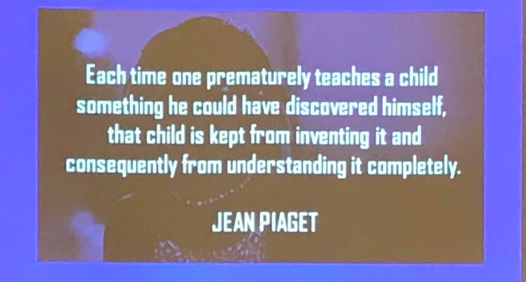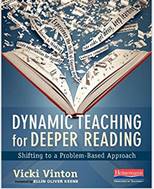 I went to see the movie Wonder adapted from the book by R.J. Palacio with my wife and two daughters. My daughters and I have all read the book. As a family we have had so many conversations about books that lead to discussions about life. I think reading helps us make sense of the world and understand each other better as people. This is true for fiction and nonfiction texts. We learn a lot about life of all forms and how they interact and behave. I think reading instruction should embrace that.
I went to see the movie Wonder adapted from the book by R.J. Palacio with my wife and two daughters. My daughters and I have all read the book. As a family we have had so many conversations about books that lead to discussions about life. I think reading helps us make sense of the world and understand each other better as people. This is true for fiction and nonfiction texts. We learn a lot about life of all forms and how they interact and behave. I think reading instruction should embrace that.
Reading instruction based solely on learning skills and strategies doesn’t motivate kids to want to read, grow and learn as humans. Readers have to have certain skills in place to learn to read, but it takes thinking through a text to bring those pages to life.
As a reader, you have to efficiently solve words and read for meaning so you can focus on the what the author really wants you to understand and to figure out how you feel as a reader and react to the text as a human. We have adapted our teaching of math to make sense for students by having them apply the skills they are learning as they will have the opportunities to do as adults, as they go into the work force and lead their lives. Should we not do the same for reading instruction? Instead we are breaking reading into isolated skills. You can learn so much about life as a reader. When we take the focus away from learning how to be a better human being as we read both fiction and nonfiction then you are taking the emotion and thus kids motivation to read. I think students are often being bombarded with the teaching of too many strategies they do not need at the time or are not ready for. Strategies they maybe be able to acquire more independently with our prompting and questioning, taking ownership of them, instead of over modeling and scaffolding by their teacher. I am not saying skills and strategies cannot be beneficial or needed, however they should not take away from reading for meaning and reading emotionally. You can still meet your curriculum requirements and teach kids to read for meaning with emotion.

The statement above is one I have really reflected on. I ask myself am I over-scaffolding my instruction and not letting students think for themselves by doing the actual thinking reading requires for them? Am I being too quick jump in and rescue them? When it comes to grit have we become a culture where it is OK to over scaffolding and do the heavy thinking for our students so we can say we are challenging them and teaching at a high level state standards often dictate. Shouldn’t I be meeting students where they are and lead them to think through a text, maybe suggesting a strategy to try after they have exhausted their own ideas, not giving it to them before they have a chance to think it through, and learn that as readers we are always evolving our thinking and often struggle. It does not come out squeaky clean on our first attempt most of the time. Even for us, that is a reason why we plan lessons.

I love this statement!
I have read a few articles lately that mention classroom reading instruction has become focused too on skills and moved away from reading for meaning, which is really the only reason we read. I have seen this happen. The skill becomes more important than reading for meaning. I know that sounds a little crazy when the skills we are teaching should help students get the meaning of the text, but it happens! Students are being asked to use all of their cognitive ability on a skill and lose the meaning of the whole piece, until the teacher comes to the rescue. Some students do need this skill work, while others do not. If you are an observer first, then you can let the student show you what they need and when they need instruction. I get the pleasure to come into classrooms & confer with kids during readers workshop. I ask them about what they are reading. I ask, What just happened? Tell me what you just read. They often cannot tell me what the text is about because they are focused on pulling out certain information, highlighting or looking for certain text features and such. These students can do what the teacher is asking but not understand why they are doing it or what it has to do with understanding as they read. The texts are often too hard even with support because the students lack background knowledge over the subject or letter sound knowledge and word solving skills. Practicing a skill often leads students away from true understanding of the text. Student are not reading for meaning. I remember hearing Debbie Miller say once that not all kids need guided reading. Those who do not, need to be reading independently. I agree with her 100%. So isn’t she saying that not all students need every reading skill in our curriculum explicitly taught to them and state standards broken down in isolation.
 Vicki Vinton talks about this and how we model how to think through a specific type of text, taking it out of the students’ hands to discover and learn on their own, even if they struggle at first. I say give this instruction to the student when they need it and will use it in books they are choosing to read. Hopefully they will develop it on their own with a little prompting on our part, but without us spoon feeding it to them by to much modeling and scaffolding. I do not want to slow some kids down, preventing them from reading for meaning and really understanding and thus enjoying reading. Modeling and scaffolding instruction are two well researched teaching strategies that have their place and are needed. We just have to be careful about the overuse of them to meet high standards. Kids must think for themselves and struggle at it sometimes, before being rescued.
Vicki Vinton talks about this and how we model how to think through a specific type of text, taking it out of the students’ hands to discover and learn on their own, even if they struggle at first. I say give this instruction to the student when they need it and will use it in books they are choosing to read. Hopefully they will develop it on their own with a little prompting on our part, but without us spoon feeding it to them by to much modeling and scaffolding. I do not want to slow some kids down, preventing them from reading for meaning and really understanding and thus enjoying reading. Modeling and scaffolding instruction are two well researched teaching strategies that have their place and are needed. We just have to be careful about the overuse of them to meet high standards. Kids must think for themselves and struggle at it sometimes, before being rescued.
Kids enjoy reading when they understand what they read, and can relate to it on an emotional level, on a human level. I think feeling and emotion are being taken out of reading instruction in many ways. I have started asking the questions, how does that make you feel? Or How do you think the author wants you to feel right now? These often throw students for a loop causing them to slow down and really think about the text. They are simple but powerful questions that get right to understanding the main idea or ideas of a text. Feeling and emotion should be allowed to go hand in hand with thinking through a text. I think that can still be done focusing on what the author says directly and infers, without letting students get lost in text to self connections that are not meaningful. I think you can still hit the skills you need to asses, focusing on reading for meaning and the emotions you go through as a reader. Vicki Vinton talks a lot about how to do this in Dynamic Teaching for Deeper Reading. I want students to enjoy reading, react to it and truly understand what they read beyond the gist and apply what they learn through reading to their lives.

2 thoughts on “Keep emotion in reading instruction.”